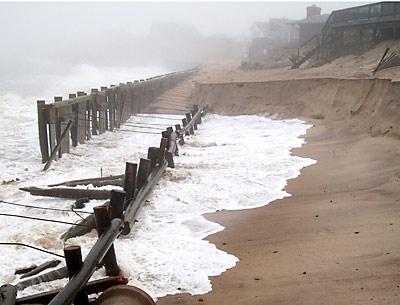Suit Over Jetty Erosion

Last Thursday 11 residents of the Soundview community in Montauk filed a lawsuit in federal court against the town, county, state, and federal governments for causing the erosion that has stolen their property and continues to leave their houses vulnerable to storms.
The timing of the filing happens to correspond with an informational meeting that the Army Corps, state, and town are holding today at the Montauk Firehouse from 5:30 to 8:30 p.m.
Although the area had been battered before, the northeast storm that tore through the region on Dec. 26 and 27, 2011, was especially damaging to Soundview. In 2011, residents sought 27 emergency permits to repair bulkheads and otherwise shore up their property.
The suit filed last week mirrors one filed in State Supreme Court in January 2011 against the town, county, and state claiming that the plaintiffs sustained $75 million in property damage, a cost that included efforts to repair the damage. The suit was dismissed by State Supreme Court Justice Arthur Pitt because it did not name the Army Corps. He ruled that the agency could be affected by the state court’s decision. Because federal agencies cannot be tried in state courts, the new suit was filed with the United States District Court for the Southern District of New York in Manhattan.
The new action alleges that the Suffolk County Department of Public Works, the State Department of Environmental Conservation, East Hampton Town, and now, the Army Corps of Engineers were responsible for constructing the jetties that define the Montauk Harbor Inlet. According to the Soundview residents, the jetties have caused the downdrift scouring that leaves their houses vulnerable.
They are asking the court to order the Army Corps and other named agencies to rebuild Soundview beaches and keep them maintained.
Last year, the Army Corps contracted the North America Landscaping, Construction, and Dredge Company of Maryland to remove dangerous shoals in the inlet caused by drifting sand. Dredged sand was pumped to the west to rebuild eroded beaches.
The dredging was successful, but is only considered a stopgap to a chronic problem that began when Lake Montauk was first opened to Block Island Sound in 1927. The shoaling continued even after the town lobbied to have the Army Corps build jetties to stabilize the inlet. The plaintiffs claim the town-owned jetties have interrupted the natural east-to-west flow of sand and caused scouring west of the west jetty while robbing the same area of sand.
Last year’s emergency dredging was not connected to the 10-year Montauk Harbor Feasibility Study, begun in 2003, that will be discussed later today. The study’s general purpose is to come up with ways to improve the channel and to greatly reduce the danger to shoreside homeowners posed by storms.
Three options will be presented. The first option is to leave things as they are. The second “navigational” option would extend the inlet’s channel (the dimensions to be determined) from Block Island Sound south to the yacht basin on the east side of Star Island. It would also provide for a deposition site, an underwater hole or trench located just offshore of the end of the east jetty. The site would collect sand before it can form dangerous shoals in the inlet.
The third proposal would include the extended channel and the deposition site and would add a series of short groins extending from the beach at Soundview.
A month ago, the Army Corps asked state and town officials to meet with the Soundview plaintiffs’ legal team to see if the particulars of the Montauk Harbor Feasibility Study could preclude a filing in federal court.
“We believe we have a good idea what the corps will present, but based on what we understand, it’s grossly insufficient,” Jonathan Sinnreich of Central Islip, the plaintiff’s attorney, said on Tuesday. Mr. Sinnreich said it wasn’t the strategy that was the problem, but rather the inability of the Army Corps to make a commitment. Funding for any approach is contingent on the willingness of Congress to pay for it.
And, there was another possible rub. According to federal law, beaches rebuilt using sand supplied by dredging projects paid for by taxpayers become public domain, complete with public access to them. Soundview residents have considered their beaches private. “We stongly believe that the replenished beach should remain private. [The erosion] was not natural. It was an action of the government. There might be a solution to that; it’s too early to say,” Mr. Sinnreich said.
Brian Frank, East Hampton Town’s chief environmental analyst, said today’s presentation would be handled by the Army Corps, but he and other town officials, as well as state, will be on hand because any fix would necessarily involve state and town participation.
Mr. Frank said the town had not yet decided which of the Army Corps approaches to support.
